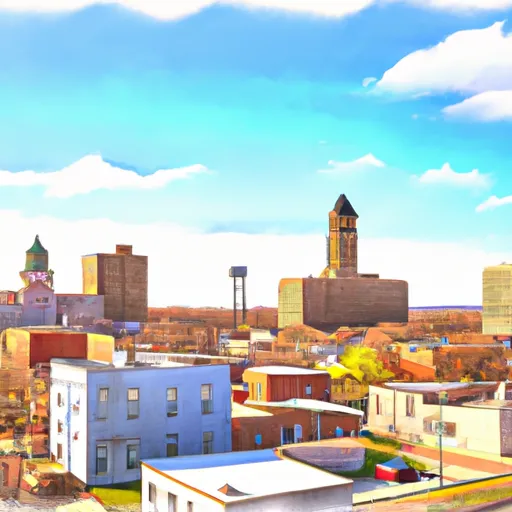-
 Snoflo Premium
Snoflo Premium
Get unlimited access to all our content
With no Ad interruptions! - Start Your Free Trial Login with existing account
Galesburg
Eden Index
Climate
8.3
•
Recreation
4.2
•
Community
0.7
•
Safeguard
5.0/10

Galesburg, Kansas is a small town located in southeastern Kansas. The climate in Galesburg is classified as humid continental, with hot summers and cold winters. The town is situated near several bodies of water, including the Neosho River and Big Hill Lake, which provide opportunities for fishing and boating. However, the area has experienced issues with water contamination from agricultural runoff and industrial pollutants. Despite these challenges, Galesburg offers a variety of outdoor recreation opportunities, including hiking, camping, and wildlife viewing in nearby wildlife areas and state parks. Additionally, the town hosts several annual events and festivals, including a Fourth of July celebration and a fall festival.
What is the Eden Index?
The Snoflo Eden Index serves as a comprehensive rating system for regions, evaluating their desirability through a holistic assessment of climate health, outdoor recreation opportunities, and natural disaster risk, acknowledging the profound impact of these factors on livability and well-being.
Climate Health Indicator (CHI): 8.3
Galesburg receives approximately
1078mm of rain per year,
with humidity levels near 84%
and air temperatures averaging around
14°C.
Galesburg has a plant hardyness factor of
6, meaning
plants and agriculture in this region thrive during a short period during spring and early summer. Most
plants will die off during the colder winter months.
By considering the ideal temperature range, reliable water supplies, clean air, and stable seasonal rain or snowpacks, the Climate Health Indicator (CHI) underscores the significance of a healthy climate as the foundation for quality living.
A healthy climate is paramount for ensuring a high quality of life and livability in a region, fostering both physical well-being and environmental harmony. This can be characterized by ideal temperatures, reliable access to water supplies, clean air, and consistent seasonal rain or snowpacks.
Weather Forecast
Streamflow Conditions
Neosho
Area Rivers
Neosho
Snowpack Depths
Neosho
Reservoir Storage Capacity
Neosho
Groundwater Levels
Recreational Opportunity Index (ROI): 4.2
The Recreational Opportunity Index (ROI) recognizes the value of outdoor recreational options, such as parks, hiking trails, camping sites, and fishing spots, while acknowledging that climate plays a pivotal role in ensuring the comfort and consistency of these experiences.
Access to outdoor recreational opportunities, encompassing activities such as parks, hiking, camping, and fishing, is crucial for overall well-being, and the climate plays a pivotal role in enabling and enhancing these experiences, ensuring that individuals can engage in nature-based activities comfortably and consistently.
Camping Areas
| Campground | Campsites | Reservations | Toilets | Showers | Elevation |
|---|---|---|---|---|---|
| Greenleaf State Park | None | 699 ft | |||
| Deep Fork - Lake Eufaula State Park | None | 629 ft | |||
| Arrowhead Point - Webbers Falls Lake | None | 530 ft | |||
| Belle Starr Park - Eufaula Lake | None | 614 ft | |||
| Brewers Bend - Webbers Falls Lake | None | 529 ft | |||
| Highway 9 Landing - Eufaula Lake | None | 618 ft | |||
| Spaniard Creek - Webbers Falls Lake | None | 506 ft | |||
| Brooken Cove - Eufaula Lake | None | 612 ft | |||
| Porum Landing - Eufaula Lake | None | 597 ft | |||
| Dam Site South - Eufaula Lake | None | 652 ft |
Nearby Ski Areas
Catastrophe Safeguard Index (CSI):
The Catastrophe Safeguard Index (CSI) recognizes that natural disaster risk, encompassing floods, fires, hurricanes, and tornadoes, can drastically affect safety and the overall appeal of an area.
The level of natural disaster risk in a region significantly affects safety and the overall livability, with climate change amplifying these risks by potentially increasing the frequency and intensity of events like floods, fires, hurricanes, and tornadoes, thereby posing substantial challenges to community resilience and well-being.
Community Resilience Indicator (CRI): 0.7
The Community Resilience Indicator (CRI) recognizes that education, healthcare, and socioeconomics are crucial to the well-being of a region. The CRI acknowledges the profound impact of these elements on residents' overall quality of life. By evaluating educational resources, healthcare accessibility, and economic inclusivity, the index captures the essential aspects that contribute to a thriving community, fostering resident satisfaction, equity, and social cohesion.

